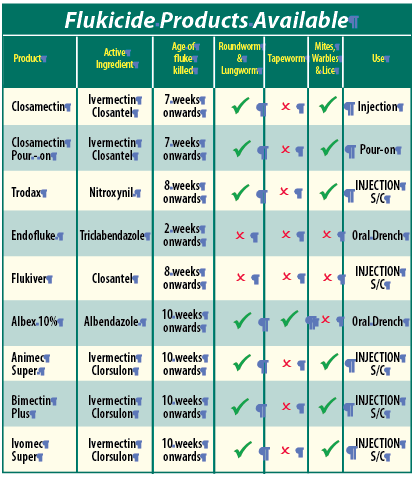Housing provides a great opportunity to control parasites in cattle as cattle only pick up these parasites when grazing. Therefore, once housed, cattle will no longer pick up new fluke or worm parasites. This means that effective parasite treatments at, or after housing should keep the animals virtually free of worms and liver fluke until they return to pasture the next year.
Dosing Commandments
- Calibrate your dosing equipment – at least once a year and ensure it is cleaned using warm water. Set a volume on your equipment, submerge pipe nozzle in water and ensure this volume is delivered in a test run.
- Rotating Wormers - Anthelmintic resistance (AR) is more likely to develop if worm populations are being exposed to the same active ingredients repeatedly. Introducing new active ingredients into an annual protocol will help to minimize the development of AR. On cattle farms this probably means reducing reliance on ivermectin and using white and yellow wormers more often.
- Weigh Animals - Every livestock farm should have a weighing scales, or access to one. In terms of resistance prevention, best practice around dosing is to weigh the heaviest animal in a group and then treat the rest based on this weight, provided there is relative uniformity throughout.
- Coughing & Lungworm - Cattle coughing when driven is a sign that there is a burden of lungworm in the system. In older cows it can also be a sign of reinfection with larvae – also dangerous. First cough in driven calves is often used as the trigger for first dose in suckler herds.
- Restrict feed pre dose - With oral white and clear wormers in sheep, restricting feed for 24 hours pre-dosing can help to optimize product efficacy. However, the practice should be avoided in pregnant ewes or other scenarios where knock-on effects on performance or welfare are possible. Drinking water should never be restricted on livestock farms.
- Embrace the hook - Cattle farmers have become over reliant on topical and injectable worming products and a shift in thinking is needed. A clever strategy for oral drenching is to source two hook drenchers, having a person hooking animals ahead of the person treating. Filling the chute relatively tightly will also help to make things easier.

Top Tip – knowledge is key when it comes to dosing. Ask your local vet if you are unsure of what product to use. Flukicides kill fluke at different stages depending on the active ingredient, therefore it is vital to use the product at the correct stage. Liverfluke has a lifecycle of 12 weeks, so for example if using a product that kills all stages of liverfluke it is best to use it in the first week when cattle are housed. If using an ivermectin based product like Closamectin it is best to wait 5 to 6 weeks from when cattle are housed to allow the fluke to mature as this product only kills mature fluke.

Benefits of Parasite Control:
Both internal and external parasites can cause a lot of damage, reducing animal performance by a reduced appetite, increasing the risk of viral and bacterial pneumonia, and thereby affecting FEED INTAKE which is the key driver of animal weight gain. Lice infestation can reduce performance by 30%.
Spot On contains the active ingredient deltamethrin, which is proven to be extremely effective at killing lice in cattle and sheep. Lice should be treated as soon as livestock enter the shed for optimum results. If you are buying in cattle this time of year it is better to wait and blanket treat the whole shed. Shaving along the spine on cattle’s backs is also a huge advantage, reducing sweating and build-up of lice.

